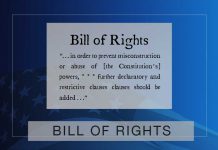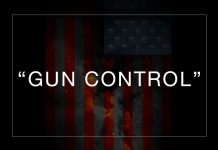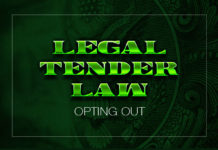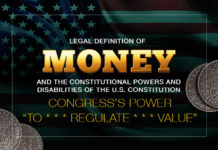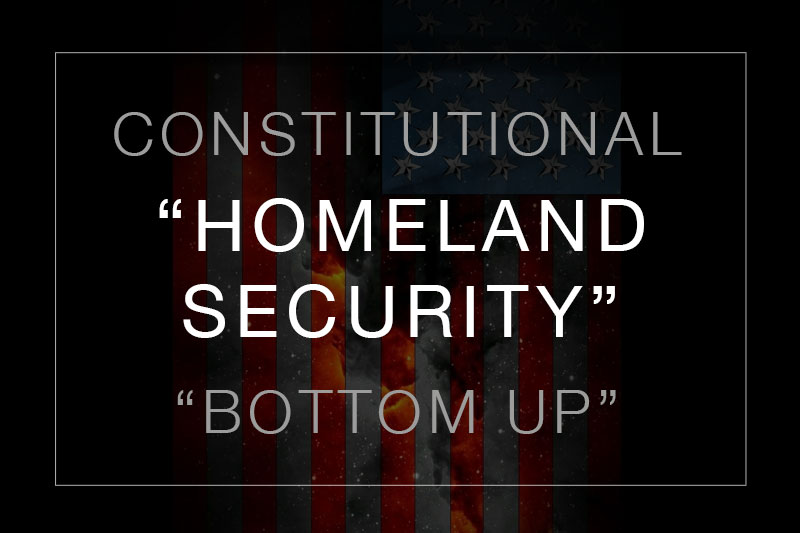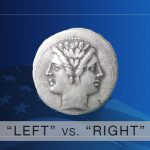Last Updated on October 8, 2021 by Constitutional Militia
[The following is the full text of a somewhat shortened address presented to the Committee for Monetary Research and Education on 15 October 2009…]
The more things change, the more they remain the same. In 1814, in an address to the House of Representatives, Daniel Webster observed that
public credit, the last reliance of government, * * * does not exist. This is a state of things calling for the soberest counsels, and yet it seems to meet only the wildest speculations. Nothing is talked of but banks, and a circulating paper medium, and exchequer notes, and the thousand other contrivances which ingenuity, vexed and goaded by the direst necessity, can devise, with the vain hope of giving value to mere paper. All these things are not revenue, nor do they produce it. * * * [N]or is there a device more shallow or more mischievous, than to pour forth new floods of paper without credit as a remedy for the evils which paper without credit has already created.[1]
Even earlier, Thomas Jefferson had predicted the reason for such a sorry state of affairs:
From the conclusion of the [W]ar [of Independence] we shall be going down hill. It will not then be necessary to resort every moment to the people for support. They will be forgotten, therefore, and their rights disregarded. They will forget themselves, but in the sole faculty of making money, and will never think of uniting to effect a due respect for their rights.[2]
Jefferson was all too prescient. Ever since his day, the political class has looked elsewhere than to the American people for support—and always found it from the financial class.
The financial class has arrayed itself on the side of the political class, and the political class has arrayed itself on the side of the financial class—not just in an incestuous coupling, but in the veritable fusion of a political-cum-financial hermaphrodite: the full integration and consolidation of bank and state.
This unholy alliance has always centered around a mechanism by means of which the financial class can create ersatz “money” out of nothing tangible—through a monopolistic national bank (the First and Second Banks of the United States), then a national banking conglomerate (the National Banks of the Civil War), and finally a fully corporative-state banking apparatus (the modern Federal Reserve System), all operating on the basis of “reserves” so increasingly fractional that they have now become essentially fictional. Through the General Government, the political class has guaranteed the continuance of this scheme, in one form or another, for more than two hundred years.
By so doing, the political class has always been able to count on the support of the financial class—but only at the cost of enabling the financial class to exercise exorbitant influence over the General Government, and through the General Government over the American people themselves.
The true name of this system is financial fascism.
As with all fascistic arrangements, it involves an axis of coöperation between big private special-interest groups and rogue public officials—in this case, the Axis of Financial Fraud that runs from Lower Manhattan in New York City to Washington, in the Disgrace of Columbia.
Whenever and wherever a scheme of this type has been put into operation, it has rested upon a threefold fraud:
First, the falsehood that the purpose of “money” is to serve some disembodied entity—“the economy”; or some institution —“the government”; or some self-selected élite—“the financial community”, rather than the people as a whole.
Second, the falsehood that “money” should be created and managed by self-styled “experts” who are politically independent of the people.
Third, and most important, the falsehood that “money” should be based upon debt, whether public or private, not upon any tangible commodity, such as silver or gold, the supply and the value of which the free market determines.
Currency generated out of debt is not an attempt to create a medium of exchange “out of nothing”, such as the irredeemable, but debt-free, legal-tender Lincoln Greenbacks of the Civil War. Rather, it is an attempt to create a medium of exchange out of something worse than nothing. For, all other things being equal, debt is always less desirable than the absence of debt. At base, currency generated out of debt is a contradiction in terms, because it purports to transform liabilities into assets. Indeed, it is more of a fantasy even than the fabled Philosopher’s Stone. For that was supposedly able to transform one asset—lead—into a more valuable asset—gold, not to turn something that was not an asset at all into something else that was.
Currency generated out of debt rests upon the delusion that increases in the stock of society’s medium of exchange will cause corresponding increases in society’s real wealth—that is, that debt can be the source of and foundation for wealth because real economic development can always be “stimulated” with new doses of debt. Of course, this naive notion that “having more money equals having more wealth” ignores the questions of whether increases in the supply of money decrease the purchasing power of all money, and of whether such increases actually undermine or even sabotage the operation of the free market, thereby decreasing real wealth. It also ignores the reality that every emission of new currency results in a redistribution of real wealth to the currency’s issuer from the society that initially accepts the new currency at its full face value and then continues to use it as it depreciates in purchasing power—that is, that the issuers of currency generated from debt are in fact embezzling wealth from everyone else.
The generation of currency out of debt is a confidence game, because it depends for its continuation upon the average citizen’s misplaced confidence in the efficacy and especially the stability of the system emitting that currency. As with every confidence game, however, reality eventually supplants illusion. As time goes by, society suffers an ever-increasing dependence upon ever-expanding increments of debt in order to generate ever-contracting increments of purported “economic growth”. The economy supersaturates with debt. Then, like the drug addict who chokes to death on his own vomit as a result of an overdose, the economy finds itself strangled by the ever- tightening cords of unpayable debt—and slips into the fatal coma of stagnation, then depression, and perhaps hyperinflation, too.
The sole constitutional power of Congress with respect to money is “[t]o coin Money, regulate the Value thereof, and of foreign Coin, and fix the Standard of Weights and Measures”.[3] Observe that this clause links as cognate powers “regulat[ing] the Value [of Money]” and “fix[ing] the Standard of Weights and Measures”, because the Constitution intends for “Money” itself to be a scientific “Standard”—rational, objective, verifiable, or falsifiable—akin to every other known or knowable “Standard of Weights and Measures”.
Although emitted under a purported delegation of power from Congress, the contemporary Federal Reserve Note, in contrast, is a standard of nothing tangible or even theoretical—as John Exter used to say, it is truly “an IOU nothing currency”. The Federal Reserve System provides this country with neither a rational, nor an objective, nor a verifiable or falsifiable standard—not even a standard predictable in its changeability—let alone anything that could be called a constitutional legal standard. Operating without a scientific monetary standard, the Federal Reserve System interferes with the free market’s formation of prices—indeed, the System’s manipulations under the rubric of “monetary policy” intentionally falsify prices, causing widespread and ineradicable economic confusion and the monumental waste of human efforts and natural resources.
Of course, America’s financial class is not composed entirely of fools devoid of foresight. Anticipating all of these problems, the financial class arranged for the political class to provide three forms of protection for different levels of systemic risk in the Federal Reserve System:
at the lowest level, the concept of “deposit insurance”, designed to gull the victims of the fractional-reserve scam into believing that the banking system can and will secure its clients against a relatively few especially imprudent operators;
at the intermediate level, the concept of “the lender of last resort”, the spigot of “liquidity” within the banking system itself which enables the system to keep afloat some (albeit not all) large financial institutions when their mismanagement threatens to sink them in bankruptcy; and
at the highest level, the concept of “institutions too big to fail”, the ultimate safety-valve to be turned on whenever the financial class’s irresponsible speculations endanger one or more segments of the economy so sizeable that only the political class can marshal an adequate “bail out” through the General Government.
The term “institutions too big to fail” is a rather sorry misnomer—because under contemporary financial fascism the big financial institutions—and, it seems, the big industrial concerns as well—are proving too rotten with corruption not to fail. They cannot help but fail, they will fail, and for rogue public officials to provide them with “bail outs” merely transfers the real burden of failure from the pocketbooks of the financial class onto the backs of the American people. Having put across the swindle of “institutions too big to fail”, though, the financial class now holds the people of the United States hostage to its manipulations. Without “bail out” after “bail out”, the financial class warns, the economy will collapse, social chaos will break out, and the invocation of “martial law” will be necessary to restore order. Thus, common Americans have been made the unwilling, but perpetual guarantors of a gigantic Ponzi scheme in which well-organized racketeers in the financial class rake in the illicit profits—their cronies in the political class secure the votes, the pensions, and the golden parachutes—and average citizens must swallow the ever- increasing losses in jobs, in productivity, in income, in standards of living, and in every other measure of economic well-being.
Americans must also suffer the loss of their fundamental freedoms, because, politically, financial fascism is neither a benign nor a static system. Its vicious principles are such that their application will drive this country to a centralized financial police state—and then to a full-blown police state in every horrific sense of that term. Already in 1791 this potential for political disaster was recognized in the debate in the House of Representatives on the First Bank of the United States, during which Representative Giles warned the country that
“all the arguments adduced in favor of [a national bank], from whatever source they arise, if pursued, will be found to rush into the great one of expediency, to bear down all Constitutional provisions, and to end themselves in the unlimited ocean of despotism.”[4]
The question then becomes: Must the Axis of Financial Fraud be suffered to “crucify America on a cross of debt”?
The answer is NO! There is a way out. The purveyors of the culture of debt at both ends of the Axis of Financial Fraud have forgotten that their pyramids of phony paper promises are still subject to constitutional law. To smash the Axis once and for all, Americans must:
(i) restore commodity money of silver and gold as the only official media of exchange for the General Government and the States;
(ii) gradually displace and replace currency generated from debt with commodity money through competition in the free market;
(iii) enforce the absolute separation of bank and state, so that common people are no longer compelled to underwrite the financial class’s Ponzi schemes; and
(iv) declare uncollectible all unconstitutionally incurred debt.
The last entry in this list bears repetition and explanation: To declare uncollectible all unconstitutionally incurred debt is entirely different from “repudiating debt”. Repudiation of debt presumes that the debt was originally lawful, but that now, for some reason, the law must be set aside, or disregarded, or changed ex post facto. In contrast, declaring uncollectible all unconstitutionally incurred debt presumes that the debt was never valid at all. But how can this be accomplished? In at least two ways:
First, under the doctrine of the Supreme Court’s decision in Craig v. Missouri,[5] all contracts, agreements, or other arrangements in which any part of the consideration consists or consisted of the emission of unconstitutional “bills of credit” through or under the auspices of any Federal Reserve Bank, “member bank”, or “depositary institution” within the Federal Reserve System are declared to be void ab initio and unenforceable in any court of the United States or of any State.
Second, all public debt obligations of the United States, howsoever made and in whatever form, that have been incurred for the purpose of raising revenue to be expended from the general fund of the Treasury in payment of costs arising under a particular budget of the United States are declared to be void ab initio and unenforceable in any court of the United States or of any State in the same percentage that the unconstitutional programs, activities, or expenditures in that budget bear to the total programs, activities, or expenditures therein. Every lender must be presumed to know the constitutional limits on the expenditures of money the General Government borrows, to the same extent that every official of that government knows those limits. So, if a lender extends a loan to public officials, knowing that his loan will be used for unconstitutional purposes, or with willful blindness to or reckless disregard of the unconstitutionality of those purposes, he is thereby a participant in a fraud against the American people. And for the repayment of such a loan, the American people cannot be held liable.
Plainly enough, though, the present Congress, President, and Supreme Court will never reform the contemporary monetary and banking systems, and reduce average Americans’ burden of debt, along these lines. That leaves it to the victims of the swindle: WE THE PEOPLE themselves. Which is quite appropriate.
After all, the real “federal government” is not the General Government alone—it is not the General Government and the States alone—rather, it is the General Government, and the States, and most importantly WE THE PEOPLE. Most importantly, because the real “federal government” is not a pyramid in which power flows up from the bottom to concentrate at the top, with an all-seeing eye at its apex. For the strength of any pyramid is found not at its apex, but in its base. WE THE PEOPLE are the essential support of the entire structure, the source of its strength, the font of political power, the ultimate sovereigns.
All too many Americans for all too long have been conditioned to think of “the federal government” in terms of “higher” and “lower” levels as on some crude bureaucratic organizational chart: with Washington, D.C. at the top, the States and THE PEOPLE at the bottom. The correct description, however, takes into account degrees of authority: The truly “highest” level is the one closest to the well-spring of sovereignty, the “lower” levels the ones increasingly removed from that source. WE THE PEOPLE occupy the “highest” level in the real “federal government”, because WE THE PEOPLE not only originally “ordain[ed] and establish[ed] th[e] Constitution”, but also sustain—and must enforce—its authority every day. As the Supreme Court has held, “[t]he power to enact carries with it final authority to declare the meaning of the legislation”.[6] Moreover, as Sir William Blackstone taught the Founding Fathers, “whenever a question arises between the society at large and any magistrate vested with powers originally delegated by that society, it must be decided by the voice of the society itself: there is not upon earth any other tribunal to resort to”.[7]
To be sure, the partisans of the Federal Reserve System will contend that the System has been declared constitutional on numerous occasions, or at least is generally treated as constitutional, and that therefore its validity cannot now be contested. In fact, however, the Supreme Court has never heard a challenge to the central-banking scheme, or its irredeemable paper currency, on the numerous grounds of their greatest constitutional vulnerability. In any event, the very same legal gurus who tout the alleged legitimacy of the Federal Reserve System—as well as the propriety of the ever-expanding expenditures of the General Government that the Federal Reserve System finances through the banks’ “monetization” of public debt—also claim that America has a so-called “living constitution”, the meaning of which can change from time to time to meet differing circumstances. If that is true, then no matter how many times in the past the Federal Reserve System and the General Government’s expenditures have supposedly been declared constitutional, WE THE PEOPLE can decide tomorrow that circumstances demand reinterpretation of this “living constitution” in order to strike down the Federal Reserve System and those expenditures, and thereby to save this country from economic disaster. Or, WE THE PEOPLE can decide on the basis of the Constitution’s “original intent” that the Federal Reserve System and expenditures of those kinds were never even arguably lawful in the first place. In either case, the Federal Reserve System and all such expenditures— and the huge mountain of ostensible public and private debt associated with them—can be eliminated.
Why WE THE PEOPLE will take this course is obvious. As the old saw has it, “Nothing focuses a man’s mind more than his impending hanging!” THE PEOPLE have been asleep for a long time. Now, however, as the economic screws tighten on every side, they have finally awakened to the danger confronting them. Everyone with an IQ even a single point higher than his age recognizes the utter and irremediable corruption of the Federal Reserve System and the entire financial and political régime centered around and dependent upon it: Consider the gargantuan “bail outs” that amount to the most mammoth, brazen, and insolent financial looting any society has ever suffered in the history of the world. Consider the régime’s refusal to accept responsibility or to provide for accountability or even minimal transparency. Consider the régime’s grab for ever-more-abusive powers, not only over the financial sector of the economy, but also over what remains of the industrial sector. In short, ordinary Americans are witnessing—and know they are witnessing—a war being waged against them by the racketeers of the financial class and rogue public officials in the outlaw city-states of New York and Washington, D.C. So far, it is a war in which only the aggressors are doing any fighting. But that disparity will not persist much longer.
As Jefferson predicted, now that THE PEOPLE are no longer making money, but instead are losing it hand over fist—and with it their jobs, their prosperity, their economic security, and their hopes for decent retirement—they have but one other alternative: They must “think of uniting to effect a due respect for their rights”. When they do, THE PEOPLE will recognize that the only way to restore their national independence, societal prosperity, and individual liberty is to break the links once and for all between bank and state and between currency and debt, using the industrial-strength tools the Constitution supplies.
How will they do it? WE THE PEOPLE must first declare and then secure their economic and legal independence from the Federal Reserve System’s régime of fiat currency and central banking within their own States and Localities. They can succeed in this endeavor because:
(i) THE PEOPLE do not need the advice, or the help, or the interference, or the direction, or least of all the dictation of anyone in Washington, D.C. or New York City to live as free and prosperous Americans in their own States and Localities.
(ii) THE PEOPLE vastly outnumber the totality of all public officials, politicians, financiers, bankers, and these parasites’ clients, partisans, hangers-on, and touts.
(iii) THE PEOPLE physically control most of the property in this country—and actual “possession is nine-tenths of the law”. If THE PEOPLE en masse and through properly organized and authorized resistance simply refused to relinquish their physical possession in defiance of the financial class’s merely paper claims, precisely what could the financial class do about it?
(iv) THE PEOPLE can still exercise an effective franchise in many States. And, most consequentially in the final analysis,
(v) THE PEOPLE constitute the Militia, which the Constitution declares to be “necessary to the security of a free State”, and to which institution alone the Constitution explicitly assigns the responsibility and the authority “to execute the Laws of the Union”.[8] Combining THE PEOPLE’S actual possession of most of the property throughout America with their authority through the Militia “to execute the Laws” would mean that the financial class could not possibly maintain its stranglehold over the economy for a single minute after THE PEOPLE decided to declare uncollectible all unconstitutionally incurred debt.
The initial step on the long march to reform is to introduce, State by State, an alternative currency of silver and gold that can compete with, and shortly replace, the Federal Reserve Note in each State’s public finances and private economy. This process must take place through the States, because:
(i) the States are large enough politically and economically to make it work;
(ii) the States have the undoubted legal authority to do it;
(iii) with respect to the choice of a currency for the performance of their own governmental functions, the States enjoy absolute legal immunity from interference by rogue public officials in the General Government;[9] and
(iv) the Militia, through which the alternative currency will quickly move into each State’s private economy, are “the Militia of the several States”.[10]
This plan is not some pie-in-the-sky vision. For several States—New Hampshire, Montana, Indiana, and Georgia, for instance—have already set out in the right direction (albeit only with halting steps so far). True enough, they and other States still have a long road to travel—but, as the Chinese say, even a journey of a thousand li begins with but a single step.
An alternative currency—introduced through the States’ governments and spread throughout the economy by THE PEOPLE themselves in their Militia—is not simply an idea whose time has come. More than that, true constitutional monetary reform will be the new “shot heard ‘round the world”, the announcement of a new American declaration of independence from the corrupt alliance of politicians and financiers that has driven this country to the brink of irretrievable disaster.
Footnotes:
2. Quoted in Merrill D. Peterson, Thomas Jefferson and the New Nation (New York, New York: Oxford University Press, 1970), at 99.
3. Article I, Section 8, Clause 5.
4. The Debates and Proceedings in the Congress of the United States (J. Gales compilation, 1834), Volume 2, at 1942-1943. 5, 29 U.S. (4 Peters) 410 (1830).
6. Propper v. Clark, 337 U.S. 472, 484 (1949).
7. William Blackstone, Commentaries on the Laws of England, Volume 1, at 212.
8. U.S. Const. art. I, § 8, cl. 15 and amend. II.
9. Lane County v. Oregon, 74 U.S. (7 Wallace) 71 (1869).
10. U.S. Const. art. I, § 8, cls. 15 and 16, and art. II, § 2, cl. 1.
©2009 Edwin Vieira, Jr. – All Rights Reserved.







